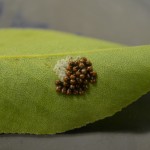


Over the past five years we have seen BMSB adults, egg laying with nymph hatch during the early part of the season. Early but limited movement of BMSB into crops has occurred prior to early August, at the onset of 2nd generation in lower to mid-Hudson Valley orchards, BUT the majority of these sites with early season BMSB presence has not resulted in economic injury. However, in a few sites, predoinately in Highland, Milton and Marlboro, BMSB has caused damage to stone fruit, especially peaches. Early injury to peaches can be seen in these images from USDA/Leskey Lab.
This event should signal intensified scouting efforts for BMSB this week, especially in sites where BMSB has caused problems over the past three years. The mid-Atlantic States have found stone fruit to be more vulnerable then pome fruit early in the season. If BMSB populations are found laying eggs with nymphs present in peach, nectarine, plum and cherry, the insect will become an economic threat to fruit. Effective insecticides for use on pome fruit are listed in the Cornell Guidelines. Efficacy ratings for use on Pome Fruit can be found here.
Bifenthrin, the most effective pyrethroid against the BMSB, is only labeled for use in pears. It was granted use on apple in 2013 as a section 18 in Dutchess, Orange and Ulster Counties. We have not yet heard from DEC regarding this years section 18 use of Bifenthrin in NY.
Endigo, the pre-mix of Lamda-cyhalothrin (A.I. in Warrior) and Thiomethoxam (A.I. in Actara), having high ratings for BMSB management. Labeled for use in peaches and nectarines at 5.5 fl.oz./A, it has a 35 day PHI in pome and 14d PHI in stone fruit. Special NY restrictions limit the use of Thiomethoxam to 0.172 lb. a.i./A. ((19.0 fl.oz./A of Endigo).
Lannate has excellent contact activity against teh insect with relatively poor residual. Lannate 2.4LV labeled on stone fruit at 2.25 pt./A 96 hour REI and 14d PHI.
Actara (Thiomethoxam), Danitol (Fenpropathrin), Leverage 360 (pre-mix – Cyfluthrin/Imidacloprid) and Voliam Xpress (chlorantraniliprole (A.I. in Altacor) and Thiomethoxam) are good choices if Bifenthrin, Endigo or Lannate are not applied.





